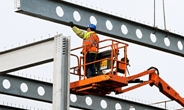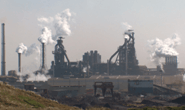Steel Products

Construction Spending Hits Record $1.329 Trillion Rate
Written by Tim Triplett
November 1, 2018
Construction spending hit a seasonally adjusted annual rate of $1.329 trillion and grew 5.5 percent for nine months of 2018, with continued year-to-date gains for major public and private categories, according to an analysis of new government data by the Associated General Contractors of America. Association officials said that while demand for construction should remain strong for the next several months, the construction sector could be impacted by new trade tariffs, continued workforce shortages and higher interest rates.
“Construction spending has increased among nearly every project type and geographic area this year,” said Ken Simonson, the association’s chief economist. “Despite month-to-month fluctuations, the outlook remains positive for modest to moderate increases in most spending categories at least through the first part of 2019. However, damaging trade policies, labor shortages and rising interest rates pose growing challenges to contractors and their clients.”
Spending year-to-date through the first nine months of 2018 was 7.0 percent higher than in January through September 2017 for public construction and 5.1 percent for private construction, the economist commented. Within private construction, spending for residential projects increased 6.4 percent, and 3.5 percent for nonresidential projects.
Major segments continued to show gains, Simonson said. The largest public categories recorded year-to-date gains of 5.8 percent for highway construction, 2.0 percent for educational construction and 15.8 percent for transportation construction. Of the three private residential spending categories, single-family homebuilding rose 6.4 percent year-to-date, multifamily was virtually unchanged and improvements to existing buildings climbed 7.1 percent. Among private nonresidential spending segments, the largest—power construction (including oil and gas field and pipeline structures)—edged up 2.3 percent, commercial (retail, warehouse and farm) construction rose 4.8 percent, office construction increased 7.4 percent and manufacturing construction declined 3.4 percent.
Association officials said that overall economic conditions remain positive as the economy continues to benefit from recently enacted tax and regulatory reforms. But they warned that a growing trade dispute with China, shortages of qualified workers and rising interest rates could undermine future demand for construction services. They urged federal officials to resolve trade disputes and boost investments in career and technical education programs.
“Washington has taken a number of positive steps to deliver robust economic growth during the past two years,” said Stephen E. Sandherr, the association’s chief executive officer. “The best thing federal officials can do to maintain current rates of growth is to resolve potentially costly trade disputes and boost investments in workforce development.”

Tim Triplett
Read more from Tim TriplettLatest in Steel Products

Final Thoughts
The difference: The spat with Turkey was a big deal for steel. This time, the 50% reciprocal tariff for Brazil – if it goes into effect as threatened on Aug.1 – hits everything from coffee and to pig iron. It seems almost custom-built to inflict as much pain as possible on Brazil.

CRU: US rebar and wire rod prices rise alongside S232 increase
CRU Senior Steel Analyst Alexandra Anderson discusses current market and pricing dynamics for long steel products in the US.
CRU: Excessive global supply could hit rebar mill investments in US
Following the onset of the war in Ukraine in March 2022, concerns about import availability and expectations of rising demand from President Biden’s Infrastructure Bill pushed US rebar prices to record highs. In response, a flurry of new mills and capacity expansions were announced to meet the rise in demand from growth in the construction […]

Steel buyer spirits tempered by soft spot market conditions
Steel sheet buyers report feeling bogged down by the ongoing stresses of stagnant demand, news fatigue, tariff negotiations or implementation timelines, and persistent macroeconomic uncertainty.

CRU: US stainless prices to rise on expanded S232 tariffs
Stainless prices in the US market will rise, following price increases by major US producers. Our base case scenario incorporates higher US prices in the near term, despite the initial negative reaction by the market. US stainless prices will go up in 2025 H2 and will stay elevated in 2026 as tariffs on stainless […]
